Cal Poly Pomona Timber Education Workshop Inspires Faculty to Create Wood-Focused Coursework
On the first day of the workshop, faculty attended seminars providing materials basics, an overview of wood education in both the undergraduate and graduate programs offered at Cal
Poly Pomona, and opportunities for research in wood design and construction. Participants also toured a nearby four-story light wood-frame housing development over a concrete podium, where they saw firsthand the practical application of wood in multi-story construction.
The second day’s discussions centered on creating the content of a wood-focused design course that the visiting faculty could take back to their own institutions, with a detailed plan of weekly lectures, student activities, and assessments. Participants learned about teaching an undergraduate-level wood design course, explored light frame and mass timber construction, and completed a hands-on exercise to create a course structure and syllabus, which they then presented to the group.
Unlike traditional concrete and steel design courses, which often focus on material properties and individual member capacities, this workshop emphasized the broader perspective of wood design. By teaching wood design, especially light-frame, engineering students gain a deeper understanding of how entire buildings function as integrated systems, with specific attention to load paths. This holistic approach better prepares students for the engineering workforce, developing insights into how buildings manage and transfer loads—an understanding that is often missing from many engineering programs.
Civil engineering faculty left the workshop better equipped to train a new generation of workforce-ready engineers with a strong grasp of wood’s benefits and practical applications.“Before attending the workshop, I was not confident in my ability to teach a timber design course,” said workshop participant Megan Voss-Warner, an Assistant Professor of Civil Engineering at the University of Evansville. “Learning about wood and hearing how experienced faculty members have designed their courses helped me build my confidence and grow a new excitement for offering this course to my students.”
Few in the engineering education space realize that wood design is underrepresented in many programs nationwide. A survey by the National Council of Structural Engineers Associations (NCSEA) revealed that while all U.S. civil engineering programs include compulsory steel and concrete design courses in their undergraduate curricula, only 52% offer wood design1, typically as an elective or a minor part of a broader hybrid course.
For more information on upcoming workshops and how to apply to attend, contact education@thinkwood.com.







